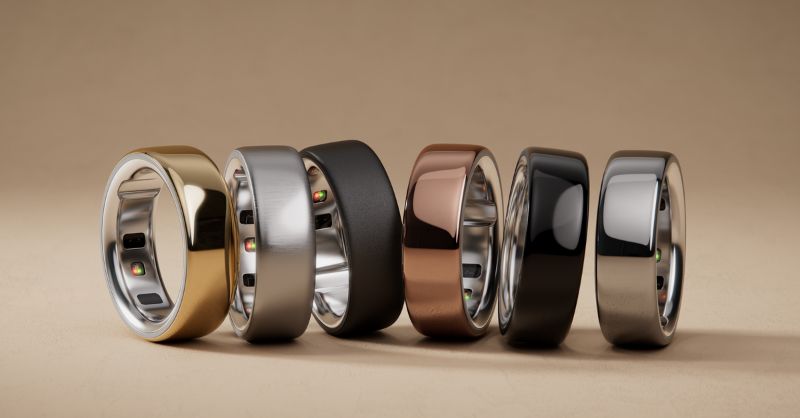In the increasingly competitive smart wearable tech market, Finnish unicorn startup ŌURA is making waves with the release of the Oura Ring 4. With competitors like Samsung, Apple, and Fitbit leading the industry, Oura aims to stake out a niche by focusing on precision, comfort, and personalisation.
Collectively, Oura has sold more than 2.5 million rings so far and is on track to reach $500 million in revenue through calendar 2024. The ring can be paired to your iPhone and they monitor users’ sleep, physical activities, and health data and have been worn by public figures like Prince Harry, Google co-founder Larry Page and Kim Kardashian.
The new Oura Ring 4 introduces “Smart Sensing” technology, a proprietary algorithm designed to enhance accuracy and comfort while tracking vital health metrics. This launch showcases the company’s determination to compete globally by offering a product that combines sleek design with advanced health monitoring capabilities.
What is smart sensing technology
The hallmark of Oura Ring 4 is its “Smart Sensing” technology, developed to offer more accurate and continuous health monitoring. Smart Sensing uses research-grade sensors that adapt to the unique anatomy of each wearer’s finger, improving data accuracy, including heart rate, sleep metrics, and blood oxygen levels (SpO2). Compared to its predecessor, Oura Ring Gen3, the new iteration boasts a 30% improvement in overnight SpO2 measurement accuracy and a 15% more precise breathing disturbance index (BDI).
ŌURA conducted a sleep clinic study in August 2024, which demonstrated the benefits of these enhancements, such as 31% fewer gaps in nighttime heart rate readings. Holly Shelton, Oura’s Chief Product Officer, emphasizes that “Smart Sensing is the future of health sensing, setting a new accuracy standard.”
Competing on a global scale
While the Oura Ring 4’s innovations may set a new benchmark in health tech, the company faces stiff competition from global giants like Samsung and Apple. These corporations have established themselves as leaders in the wearable market by integrating advanced health features into their smartwatches, making Oura’s challenge one of differentiation. However, Oura’s focus on a unique form factor—a ring instead of a watch—offers a more subtle and less obtrusive experience, which could appeal to users who prioritize minimalism and comfort.
In addition to global competition, Oura is leveraging partnerships with retailers like Amazon, Best Buy, and Target to broaden its reach. With a price starting at $349, the ring is positioned as a premium offering, appealing to those who value cutting-edge health technology. Moreover, Oura’s focus on health insights, especially in areas like stress, women’s health, and heart monitoring, has driven a shift in its demographic, with a growing number of female users.
Users will now get tailored insights and a redesigned app
To complement the hardware improvements, Oura has reimagined its mobile app to provide a more streamlined experience. The redesigned app now organizes data into three sections—Today, Vitals, and My Health—allowing users to easily track short-term behaviors and their long-term impacts. The app also emphasizes personalized health insights, helping users understand the effects of habits like sleep hygiene and aerobic activity on their long-term health.
“With this redesign, the Oura App connects the dots to help Oura Members understand how their habits and behaviors today… impact their health as they age,” Shelton told CNBC.
Oura has also expanded its offerings into new areas like metabolic health and women’s health, with features such as Cycle Insights and the new “Fertile Window” tool, designed to help members track ovulation and fertility. These developments are part of a broader strategy to attract a growing female user base, which now constitutes the fastest-growing segment of Oura’s membership.
Finnish innovation in a global marketplace
Founded in 2013 in Oulu, by Petteri Lahtela, Kari Kivelä and Markku Koskela., ŌURA has made significant strides in the global wearables market by tracking biometric data much like a smartwatch — focused on users’ sleep. Its focus on scientifically validated health metrics sets it apart from many competitors, positioning it as a leader in preventive health. However, its challenge lies in differentiating itself in a market dominated by multinational corporations that have deeper pockets and broader brand recognition.
Further, the company has raised more than $148 million in total, reaching a $2.55 billion valuation in April 2022.
Oura’s emphasis on health data accuracy, combined with a unique form factor, offers a compelling alternative to mainstream smartwatches. Yet, the company’s long-term success will depend on its ability to continue innovating while maintaining partnerships and growing its membership base.
What do we think about the new wearable gadget
ŌURA’s Oura Ring 4 signals the company’s commitment to staying at the forefront of wearable technology. While facing fierce competition from tech giants like Samsung and Apple, Oura’s unique offering—coupled with its focus on precision health monitoring and user personalisation—gives it a fighting chance to maintain its position in a growing market.
By continually enhancing both the hardware and the user experience, Oura is aiming to establish itself as a leader in health-focused wearables, with a particular appeal to users seeking minimalistic design and cutting-edge health insights.
“Oura Ring is designed to be a personal health companion, giving our members a holistic view
of their health by pairing personal data with meaningful, actionable insights to facilitate
long-term changes,” said Tom Hale, ŌURA CEO. “The next-generation Oura Ring 4, reimagined
Oura App, and the development of the Smart Sensing platform represent significant steps
forward for wearables across accuracy, comfort, personalization, and design. We’re committed
to continuing our relentless pace of innovation, delivering exceptional value to Oura Members.”
The post Finnish innovation: Will Oura Ring 4 lead the smart ring market? appeared first on Tech Funding News.
